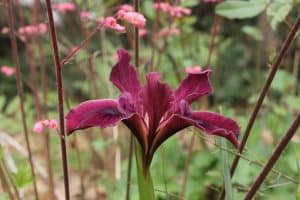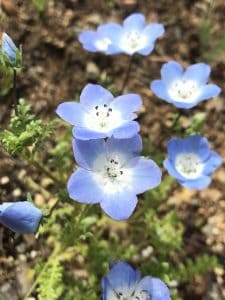This is a great season for gardens and gardeners. With the equinox (Latin aequi = equal, nox = night) behind us (March 20) and spring season ahead, daylight hours are on the increase, weather is warming up, birds and bees are busy. Naturally as true now as when it was penned by Lord Tennyson in 1835… “In the Spring a young man’s fancy lightly turns to thoughts of love.” Yes but love of what? Gardening of course. Old men too. And don’t forget all them womenfolk. Love for digging holes, planting, watering, pruning, and tending the garden, for indeed gardens are expressions of love.
I don’t know the odds, but I’m pretty sure the chances for rain decrease exponentially every day after some arbitrary date in April, maybe earlier. This is not to say our rains are finished, but as we get closer to May, don’t count on them. 2017/18, another warm dry winter with a couple late and severe frost/freeze events, a lot of wind, paltry rains. Not to jump too far ahead but… summer is right around the corner. We have some catching up to do. Check your soil. It might be drier than you think.

Watering
The truth is that the normal season for healthy soaking rains is over. Plants are actively growing and we still have April, May, and June to prepare for summer heat in July, August and September. Since natural gardens are properly watered with deep infrequent soaks, it may be time to start this month. In most years, we look to mid-May for our first real irrigation, but this year is dry. Be sure to follow the instructions in our Watering Guide. The key is to water in early morning, three days in a row, with each day’s watering adding up to provide a cumulative total equivalent to 1.5 – 2” precipitation. All the details are in the free download above. Know this: You are not watering now because the plants look like they need it. You are watering now to charge the soil with deep moisture, which will make summer irrigation easier. If we do get more rain before June, it will be a bonus.
Related to Watering
If you have recently planted new plants, congratulations. This is an ideal time. But here’s the trick: You are managing the moisture in two root zone. First, the nursery root ball of the freshly installed plant. Second, the surrounding soil where you want roots to explore as the plants grow and mature. Be careful to not let either zone dry out, (or stay overly saturated) and pay close attention to the nursery root ball. Water each new plant by hand, using a soft rain nozzle on a hose-end watering wand. You may have to water the new plants more frequently than the surrounding soil. The best indication is to dig into the soil with your finger. If the soil is dry 3-4” deep, it is time to water.
Pruning
As spring blooms fade, you can trim the seed heads off, or choose to leave some on, so that you will have seed this summer. Ceanothus should be pruned to remove the branch tips and old blooms. Pretend you are a deer, munching on perimeter of the whole plant. Penstemon bloom longer. If you allow seed to mature on some of the flowering stems, you can save them, plant them next fall, and watch your garden become increasingly wild. Seeds will be ripe in June/July. Most spring pruning involves shaping, heading back branch tips, and removing old flowers.
Weeding
Yes. Until you have a completely full, stable, self sustaining facsimile of a functional ecosystem, you will have to stay on top of weeds. As your garden becomes wilder by the season, make sure you are not pulling volunteer seedlings of your desirable plants. Compare the leaves and take a guess. If in doubt, let it grow until you are sure whether it is a weed or not.
Mulching/Top dress
You do not need to wholesale renew or revive your mulch. The most valuable organic top dress is one that has been in place a while, has mellowed, and has established a consistent moisture holding capability. Old mulch is usually better than new mulch, so don’t renew it just because everyone else is doing it. The best organic topdress is the leaf mulch naturally made by mature plants dropping their leaves.
Feeding
This is a great month to apply your spring feeding. Just prior to a rain or irrigation event, broadcast a balanced plant food, preferably organic, and scratch it into the top 1” of soil. The irrigation will dilute it and send the nutrients to the roots. Follow label instructions for rates.
Troubleshooting – Varmints, Pests and Diseases
Watch for beneficials that feed on the bad guys – birds, lacewing, ladybug larvae, mantis – and strive to create a healthy, balanced ecosystem so the pests will never get out of control. The first signs of Argentine ants – use a growth regulator bait. Eliminate them. They always work against you. Gophers, grrrrrrr – use traps and/or invite raptors to come over for dinner. Injurious insect plant pests – first make sure they are bad guys, then use strong spray of water. As a last resort, use insecticidal soap, neem oil. Avoid poisons. Disease problems – not generally apparent in April. The goal is to create and maintain a naturally balanced ecosystem-style garden, where pests are minimal and beneficials do their job. Send questions to gardenhelp@treeoflifenursery.com.

Annual Wildflowers
If you sowed seed last fall/winter, you have flowers now. Yippee. Believe it or not, you can still sow wildflower seed for the last of our rains and the first of your watering to make them germinate and grow. They will attain only a small stature, flower early, and not be very prolific. But a few small flowers are better than none. Do this as soon as possible. The window is closing on this one. Like tomorrow.
Adding New Plants
Yes, yes, and yes. Perfect time for planting. Come and select from our huge inventory. Our plants are looking really good right now. And the swallows are back.
Engage
What better time to go outdoors, even further afield than your own wild garden. The hills are alive, the mountains are calling and the deserts are as welcoming as they can be. Inspiration everywhere. Love is in the air. Go breathe some.
From the Garden, and Happy Easter!
Mike Evans
Questions? Help is just one call or one email away. Call (949) 728-0695 or email (with pictures if you like) our special helpline: gardenhelp@californianativeplants.com.